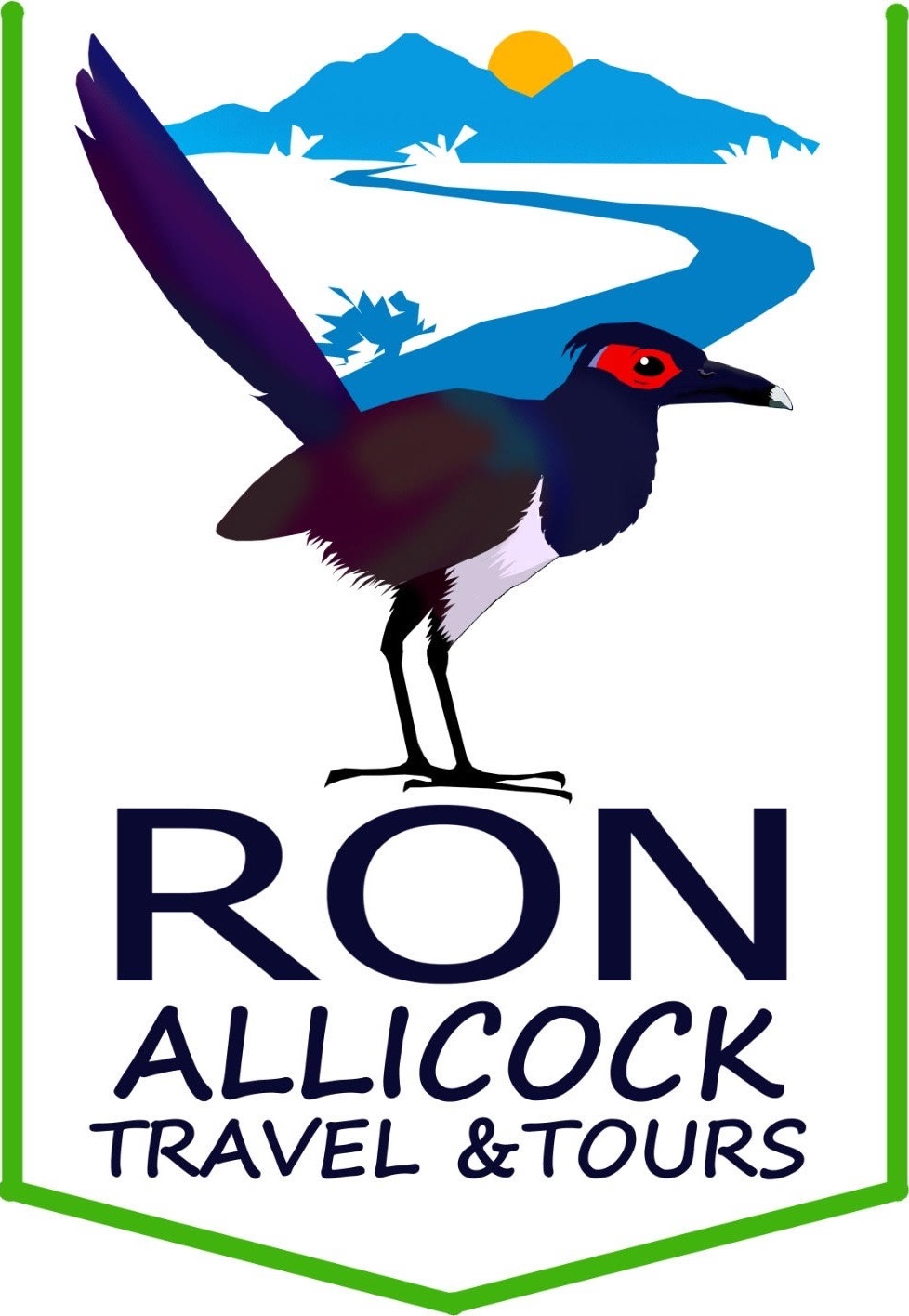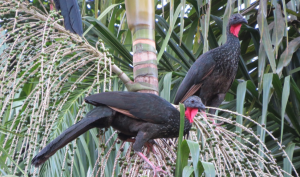Guyana really does offer something special: a small South American country nestled on the Atlantic Coast east of Venezuela and west of Suriname, it is one of the last unexplored wild places on earth yet offers incredible access into a great variety of pristine habitats.
It is also a land of great contrasts as you leave behind the coastal city of Georgetown travelling into the interior, over vast unspoilt forests and incredible isolated waterfalls. The lure of Guyana is its true wilderness and amazing wildlife with many sought after species easier to see here than any of the surrounding countries.
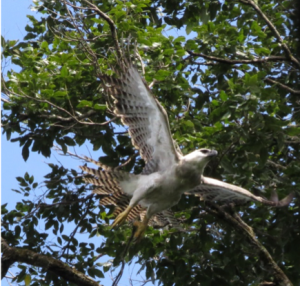
We have worked hard to offer the most complete itinerary available, which includes all the top sites visited by other companies, but also includes the spectacular Kaieteur Falls and highly favoured rarities such as Orange-Breasted Falcon, Red and Black Grosbeak, Guianan Red Cotinga, Rufous-winged Ground-Cuckoo, Crimson Fruitcrow, Rufous Potoo, White-winged Potoo, Harpy Eagle, Crested Doradito, Bearded Tachuri, Sun Parakeet, Red Siskin, Rio Branco Antbird and Hoary-throated Spinetail.
We only use the very best local guides and you can rest assured that your money will go to help Guianan-owned lodges and local communities. If you want to see the Guianan Shield Endemics including the Guianan Cock-of-the-Rock, cotingas, parrots, macaws and the bizarre Capuchinbird and an endless supply of mouth-watering species then this could be your best trip ever! We offer the No. 1 trip to this fabulous country
DAY 1 ARRIVE GUYANA
Today is planned as arrival day. Flights to Georgetown, Guyana, usually arrive after dark at Cheddi Jagan International Airport, located 25 miles south of the capital city, Georgetown. You’ll be met at the airport by our local guide and driver, who will be carrying a sign that says RON ALLICOCK BIRDING TOURS on it. After a brief welcome at the airport, you will be transferred directly to your comfortable hotel where your room will be ready for immediate occupancy and a comfortable night’s rest. The next morning will be an early start.
Overnight at Georgetown hotel (no meals included today)
DAY 2 GEORGETOWN: MAHAICA RIVER, BOTANICAL GARDEN
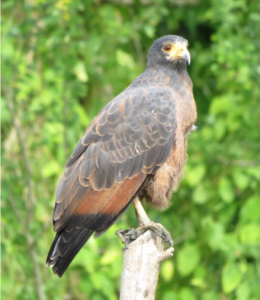
Rufous crab hawk – photo by Ron Allicock
This morning we’ll leave our hotel at 5:00 AM (having downed a cup or two of caffeine to help us get started!) and heading eastward along the Atlantic, we’ll make a few stops to check out the mud flats for Scarlet Ibises as they set out to feed at dawn. We will continue towards the community of Mahaica where we’ll take a boat trip along the river. Among our targets will be Guyana’s national bird, the bizarre, primitive Hoatzin, which is found in abundance on this river system. We’ll also look for a host of other species including the Rufous Crab Hawk (localized), Black-collared Hawk, Black Hawk-Eagle, Long-winged Harrier, Barred Antshrike, Silvered Antbird, Striped Cuckoo, Little Cuckoo, Green-tailed Jacamar, Golden-spangled Piculet, Mangrove Rail, and Mangrove Cuckoo.
Depending on the level of the river, we may be able to check the shoreline for birds such as Scarlet Ibis, Least, Semipalmated and Western Sandpipers, Whimbrel, Black-bellied and Semipalmated Plovers, Short-billed Dowitcher, Tricolored Heron, Yellow-crowned Night-Heron, Little Blue Heron, Magnificent Frigatebird, Royal, Gull-billed and Least Terns, and Brown Pelican.
After lunch in Georgetown, we’ll visit the Georgetown Botanical Gardens, an area of parkland with open grass, scattered trees, bushes and several ponds and wet areas. Here we will target several special birds including Blood-colored Woodpecker, White-bellied Piculet, the gorgeous Spotted Tody-Flycatcher, Rusty-margined Flycatcher, Southern Beardless and Yellow Tyrannulets, Lesser Kiskadee, Black-capped Donacobius, Yellow Oriole, Yellow-chinned Spinetail, Wing-barred Seedeater, Straight-billed Woodcreeper, Black-collared Hawk, and plenty of Snail Kites.
In the tree tops, we’ll hope to see Red-shouldered Macaw, Orange-winged, Yellow-crowned and Mealy Amazons, and, with luck, the Festive Amazon, a species in serious decline due to the illegal pet trade. If the trees are flowering, we’ll search for hummingbirds such as Black-throated Mango and White-chested Emerald and Plain-bellied Emeralds.
Overnight at Georgetown hotel (B, L, D)
DAY 3 KAITEUR FALLS, IWOKRAMA RIVER LODGE
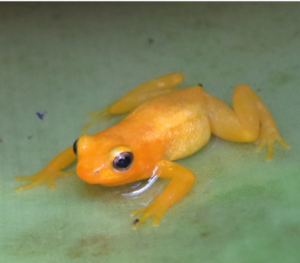
Golden rocket frog at Kaieteur Falls – Photo by Ron Allicock
After breakfast at our hotel, we will take a chartered flight over unspoilt pristine forest to Kaieteur Falls, the world’s highest free-falling waterfall. Though Venezuela’s Angel Falls is greater in total height, its filamentous drop occurs by stages, whereas Kaieteur is a single massive, thundering cascade 100 meters wide, created as the Potaro River makes a sheer drop of 228 meters, nearly five times the height of Niagara Falls. The spectacle is even more impressive for its remoteness. It is altogether possible that we’ll be the only persons viewing it.
Here, we will hope to find White-chinned and White-tipped Swifts swirling over the gorge, and perhaps we’ll be lucky enough to have our first sighting of the astonishingly colorful Guianan Cock-of-the-Rock and see an Orange-breasted Falcon as it hunts for its favorite prey, the swifts. We should also be able to find the rare and endemic Golden Tree Frog that lives in water held in the leaves of giant bromeliad plants.
Our flight departure time is dependent on the weather conditions. There will be plenty of bottled water, soda drinks, sandwiches, nuts, and crackers for lunch. Weather willing, after a 2-hour stop at the falls, our flight will continue to Fairview Village where we’ll be transferred to Iwokrama River Lodge in the heart of Guyana’s beautiful rainforest. Arriving at the lodge by 3 pm, we’ll settle into our accommodations prior to a boating excursion on the Essequibo River before dark. This impressive surrounding forest protects a unique ecosystem in the heart of the Guianan shield where Amazonian and Guianan flora and fauna form one of the highest species biodiversities in the world. Our comfortable lodge has modern cabins each with balconies that overlook the beautiful Essequibo River. There will be plenty to look at with Pied Lapwings, Black-collared and White-winged Swallows over the river, and a host of species in the surrounding forest edges. With luck we may come across Spotted Antpitta, Rufous-capped Antthrush, Ringed and Waved Woodpeckers, Slaty-capped Shrike-Vireo, Helmeted Pygmy-Tyrant, Black-necked and Green Aracaris, Guianan Toucanet and possibly Red-rumped Agouti or a family of Red Howler Monkeys.
Overnight at Iwokrama River Lodge (B, L, D)
DAY 4 TURTLE MOUNTAIN
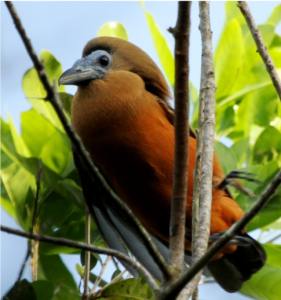
Capuchinbird in full lekking display – photo by Ron Allicock
Don’t be surprised if you are awakened by the dawn calls of Spectacled Owl or Slaty-backed Forest-Falcon. Afterward, we will bird the trails around the lodge and visit a nearby Capuchinbird lek. To see and hear these strange birds displaying is a truly unique experience. We have had the pleasure of this experience on previous trips. We’ll be up early birding the trails and then taking a boat trip on the Essequibo River. Turtle Mountain will be our objective where we will explore the main trail, visit Turtle Pond, and climb to an elevation of about 900 feet for a spectacular view of the forest canopy below.
The trail to Turtle Mountain winds its way through beautiful primary forest where Red-and-black Grosbeak, Golden-sided Euphonia, Orange-breasted Falcon, Blue-and-yellow and Scarlet Macaws, Ornate Hawk-Eagle, Cream-colored Woodpecker, Yellow-billed Jacamar, Tiny Tyrant-Manakin, Black-chinned Antbird, Amazonian Antshrike, Ferruginous Antbird, Sunbittern and possibly Brown-bearded Saki Monkey can all be found.
The trail up the mountain is physically challenging but if you are up for the challenge, it has hand rails which were put there to help you walk at your own pace. The view from the top is indeed breathtaking – a once-in-a-lifetime opportunity for you to enjoy nature at its best. We may see a fly-by King Vulture, Swallow-tailed Kite, Short-tailed Hawk or Red-and-green Macaw, while mammals here include Red Howler Monkey and Black Spider Monkey. We’ll return to River Lodge for lunch and in the afternoon, go birding in the environs of the lodge. Depending on how active the area is, we can go for a walk on one of the nearby forest trails to pick up on some Antbird species we may have missed. However, the ideal thing would be to find a swarm of army ants leading us to a Rufous-winged Ground-Cuckoo, a Spotted Antpitta, or a Red-billed Woodcreeper, which are all possible in the area.
Overnight at Iwokrama River Lodge (B, L, D)
DAY 5 ATTA LODGE, CANOPY WALKWAY
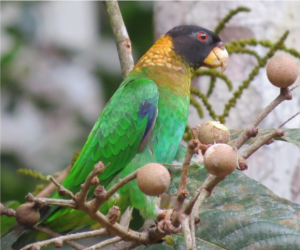
Caica parrot feeding on fruits – photo by Marissa Allicock
This morning, departing River Lodge after an early breakfast, we’ll bird on the road along the way to Atta Lodge. Some forest birds are very elusive and hard to see, including Rufous-winged Ground-Cuckoo, Guianan Shiffornis, Black Curassow, Grey-winged Trumpeter, Black-throated Antshrike, Chestnut-rumped and Long-tailed Woodcreepers, Brown-bellied, Rufous-bellied and Long-winged Antwrens, Fasciated Antshrike, White-throated Toucan, and Golden-collared Woodpecker. By chance, we may even find an Amazonian Pygmy-Owl.
This is a very productive road, as you will see, and the birding simply spectacular. In the stunted white-sand forest known as Mori Scrub, we’ll look for Black Manakin, Rufous-crowned Elaenia, Cinnamon Attila, and nearby we will search Bronzy Jacamar, White-crowned Manakin and White-fringed Antwren. This will also be a fantastic opportunity to spot the magnificent Jaguar, but obviously a lot of luck will be involved. From open areas we can check tree tops for the amazing Red-fan Parrot, Dusky Parrot, Red-and-green Macaw, Caica Parrot and possibly Blue-cheeked Amazon, and Painted and Golden-winged Parakeets. Forest edges may reveal Lineated, Waved, Yellow-tufted, Golden-collared and Cream-colored Woodpeckers, Green-tailed and Paradise Jacamars, Rufous-rumped Foliage-Gleaner, Guianan Shiffornis, Gray-winged Trumpeters, Black Curassow, and, with good fortune, the stunning Guianan Red Cotinga or the even more stunning Crimson Topaz, which comes out and fly catches in the early morning and evening.
We Plan to arrive at Atta Rainforest Lodge in time for lunch. During the afternoon and into the evening, we will walk forest trails where an optional night walk into the forest will target the much sought-after White-winged Potoo.
Overnight at Atta Lodge (B, L, D)
DAY 6 ATTA LODGE, CANOPY WALKWAY
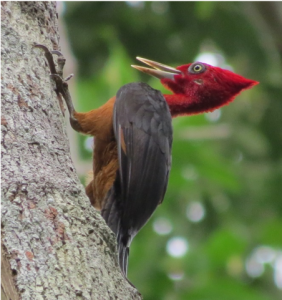
Red-necked woodpecker – photo by Ron Allicock
To spend the night at Atta Rainforest Lodge is to spend the night surrounded by pure nature with only the sounds of the forest. At dawn, we will visit the canopy walkway to look for passing flocks of canopy-dwelling species. Time will be spent looking for Todd’s Antwren, Spot-tailed Antwren, Short-tailed Pygmy-Tyrant, Guianan Toucanet, Green Aracari, Painted Parakeet, Screaming Piha, Black-headed Parrot, Guianan Puffbird, Dusky Purpletuft, Paradise Tanager, Opal-rumped Tanager, Golden-sided Euphonia, Purple and Green Honeycreepers, Black-faced Dacnis and Black Nunbird.
This entire morning will involve birding on the canopy walkway and the trails around the lodge. This wonderful area is famed for its variety of colorful cotingas and if we can locate a few fruiting trees we will be in for an avian spectacle with possibilities of Pompadour, Purple-breasted, and Guianan Red Cotingas, as well as White Bellbird and the outrageous Crimson Fruitcrow. Within the forest that surrounds the lodge, we’ll look for Red-legged and Variegated Tinamous, Gray-winged Trumpeter, Cayenne Jay, Amazonian Barred Woodcreeper, Red-billed Woodcreeper, Helmeted Pygmy-Tyrant, Ferruginous-backed Antbird, Waved, Chestnut and Red-necked Woodpeckers, as well as Black Spider Monkey and White-faced Saki Monkey.
After lunch, we will spend the afternoon birding on the main road through the Iwokrama Forest. We can try again for Black Manakin and Rufous-crowned Elaenia as well as Blue-backed Tanager, Swallow-winged Puffbird, Black-chinned, Scale-backed and Gray Antbirds, Guianan Streaked Antwren, Amazonian and Mouse-colored Antshrikes, Reddish Hermit, Tiny Tyrant-Manakin, Rose-breasted Chat, Black and Red-throated Caracaras, Guianan Trogon, Golden-winged Parakeet and Yellow-green Grosbeak. While birding along the road, we will also keep watch for the elusive Jaguar and Tapir, which are often seen at dawn and dusk.
Late evening, on our way back to Atta Lodge, we’ll use a spotlight to do some night birding, mainly looking for owls and potoos. Beside a small wetland we could find Dwarf Caiman, Uniform, Ash-throated, and Russet-crowned Crakes, as well as a Zigzag Heron, all of which are difficult. This is a great place to look for potoos, but it must be stressed these birds can be very hard to find. Nevertheless there are possibilities for White-winged, Rufous, Great, Common, and Long-tailed Potoos, plus Spectacled and Crested Owls.
Overnight at Atta Lodge (B, L, D)
DAY 7 DRIVE TO SURAMA VILLAGE
Today, it will be an early start in 4×4 vehicles for a 30-minute drive to the lek of the Guianan Cock-of-the-Rock where we’ll have our second chance to see this beautiful bird. Hopefully having seen the bird well, we will continue to Surama Eco-Lodge, birding on the way. We plan to arrive at the lodge for lunch and a well-deserved cold beer or cold drink of your choice. Birds in the forest on our return walk may include the shy Rufous-winged Ground-Cuckoo and Rufous-throated Antbird.
After lunch, we’ll bird along the forest edges and visit nearby roosts of a Great Potoo. We may find Grassland Sparrow, Wedge-tailed Grass-Finch, Forest Elaenia, White-throated Toucan, and Fork-tailed Palm-Swift Finch’s Euphonia and time permitting we will try for the Ocellated Crake. At dusk, White-tailed Nightjar, Least Nighthawk, Lesser Nighthawk, Tropical and Tawny-bellied Screech-Owls will be quite likely.
Overnight at Surama Eco-Lodge (B, L, D)
DAY 8 HARPY EAGLE TRAIL
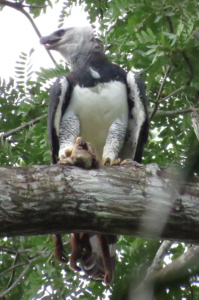
Harpy eagle with red howler monkey to feed the chick – photo by John Christian
Today will be dedicated to seeing the Harpy Eagle at its nesting site. A 30-minute drive from Surama Eco-Lodge will bring us to the Harpy Eagle nature trail. We’ll walk for an hour on a flat trail through virgin rainforest and hope to see the Harpies at their nest. If they are not there, we will wait for them to return from hunting. On past trips, we have witnessed the adults bringing in their prey including monkeys, sloths, iguanas, macaws, and the Red-Rumped Agouti.
We’ll have lunch back at the lodge. Then in the late afternoon, we’ll do a final walk on the forest trails around the eco-lodge where there are excellent opportunities for birding. Swarms of army ants may be encountered patrolling the forest floor in search of prey. Species that can be found here include Capuchinbird, Red-legged Tinamou, Black-spotted Barbet, Green Aracari, Black-necked Aracari, Guianan Toucanet, Green-backed Trogon, Marail Guan, Red-throated Fruitcrow, Golden-collared Woodpecker, Spotted Puffbird, Yellow-throated Flycatcher, Buff-throated Foliage-gleaner, Amazonian Barred Woodcreeper, Black-banded Woodcreeper, Olivaceous Woodcreeper, Chestnut-rumped Woodcreeper, Eastern Slaty Antshrike, Tiny Tyrant-Manakin, Golden-headed Manakin, Rufous-throated Antbird, White-plumed Antbird, Scale-backed Antbird, Spotted Antpitta, and even Crimson Fruitcrow and Rufous-winged Ground-Cuckoo.
Overnight at Surama Eco-Lodge (B, L, D)
DAY 9 DRIVE TO YUPUKARI
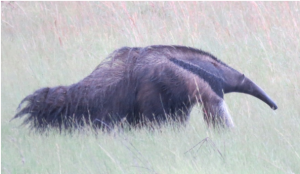
Giant anteater feeding near Kwatata village – photo by Ron Allicock
Today, our journey will take us across the Northern Rupununi Savannah. The road we’ll follow skirts numerous gallery forests and wetlands offering great views of a variety of herons, ducks, Jabiru, possibly Pinnated Bittern, Great-billed Seed-Finch, Bicolored Wren, Gray Seedeater, Grassland Yellow-Finch, Yellowish Pipit, White-fringed Antwren, Crested Bobwhite, Green-rumped Parrotlet, Yellow-hooded Blackbird, the colorful Orange-backed Troupial, and the agile Aplomado Falcon. We may even encounter a Giant Anteater if we are lucky.
In the afternoon, we will bird the local forest and some ponds where we’ll hope to see Sunbittern, Azure Gallinule, White-faced Whistling-Duck, White-headed Marsh Tyrant, White-browed Antbird, Buff–breasted Wren, Pale-tipped Inezia, Blue-backed Manakin, Striped Woodcreeper and maybe Undulated Tinamou. An evening excursion to the open grasslands as the sun sets should see the end of a magical day with White-tailed Nightjar, Spot-tailed Nightjar, Nacunda, Least and Lesser Nighthawks.
Overnight at Caiman House Lodge (B, L, D)
DAY 10 CRESTED DORADITO & BEARDED TACHURI QUEST
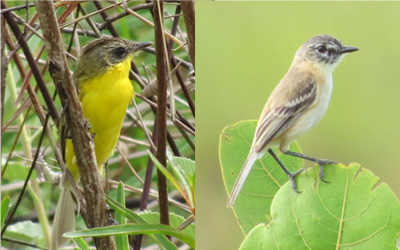
Crested doradito and male bearded tachuri near Yupukari -photo by Ron Allicock
This morning, we will start with a cup of Brazilian-style coffee before heading out into the Rupununi Savannah by 4×4. As we move across the savannah, we’ll scan the vast wetland areas for the sought-after Bearded Tachuri plus Sharp-tailed Ibis, Yellowish Pipit, Pinnated Bittern, Brazilian Teal, White-tailed Goldenthroat, Vermilion Flycatcher, Bicolored Wren, Double-striped Thick-knee, Burrowing Owl and Maguari Stork. We’ll also check an area where the rare and localized Crested Doradito was recently discovered.This is also our best chance to see the remarkable Giant Anteater in habitat that is perfect for it and Savanna Fox.
In the afternoon, we’ll have an opportunity to do a boating trip on the Rupununi River. Depending on the water lever, we will visit an oxbow lake and focus on seeing the rare Lesser Razor-billed Curassow, our best chances of seeing this bird is along the river banks as they come to drink water in the afternoon.
We are also likely to find Green-and-rufous and Amazon Kingfishers, Rufescent Tiger-Heron, Agami and Capped Herons, Sungrebe, Sunbittern, Pied Lapwing, Boat-billed Heron, Common Potoo, Band-tailed Nighthawk, Bare-necked Fruitcrow and Spot-breasted Woodpecker. In addition, we may be lucky enough to see Giant River Otter, Capybara, Black Caiman, Spectacle Caiman and many species of monkeys and even the occasional Emerald Tree Boa and Amazonian Tree Boa as they come out to feed just as it gets dark.
Our sunset expedition wraps up with a delicious and hearty dinner back at the Caiman House Lodge.
Overnight at Caiman House (B L D)
DAY 11 FLY TO GEORGETOWN
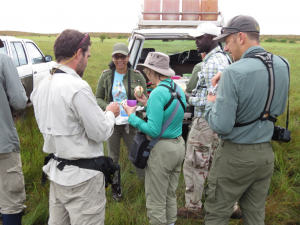
Marissa Allicock serving snacks on one of our extended day trips.
After a final early morning birding around Caiman House Lodge. We will enjoy our last breakfast together, before driving to Lethem to board our schedule flight back to Georgetown’s Ogle International Airport. We usually book the afternoon flight, so depending on the availability of the flight on the day of travel will determine where we will have our lunch; we might have it at Caiman House or at a local restaurant in Lethem. The flight takes just about 90 minutes. Dinner will be served at our hotel in Georgetown..
Overnight at Georgetown hotel (B,L,D)
DAY 12 DEPART GUYANA
Today you will depart Guyana. We’ll arrange to get you to the airport in good time for your check in and departure. (B)
$4,285 USD
12 days / 11 nights
Price per person, based on double occupancy
Single supplement: $200USD
Minimum 6 guests to operate, maximum size: 8 guests
$3,985 USD
Price per person, based on double occupancy
Click here to see the no-flights version of this trip
TARGET SPECIES
- Sun Parakeet
- Red Siskin
- Guianan Cock-of-the Rock
- Crimson Fruitcrow
- White-winged Potoo
- Crested Doradito
- Bearded Tachuri
- Sharp-tailed Ibis
- Green Aracari
- Hoatzin
- Hoary-throated Spinetail
- Crested Eagle
- Harpy Eagle
- Capuchinbird
- Blood-coloured Woodpecker
- Rufous Crab Hawk
- Guianan Red Cotinga
- Red-and-black Grosbeak
- Pompadour Cotinga
- White-naped Xenopsaris
- Spotted Puffbird
- Rufous-winged Ground-Cuckoo
- Rio Branco Antbird
WHAT'S INCLUDED
- Airport transfers
- Double or twin accommodation
- Meals as listed on itinerary (B,L,D)
- Snacks and water daily
- All road and river transfers
- Internal flights in Guyana
- Activities as described
- Local guides
- 14% VAT
- Iwokrama Forest User fee
- Iwokrama Canopy Walkway fee
- Kaieteur National Park fee
- Local birding guide
NOT INCLUDED
- Items of a personal nature
- Alcoholic drinks
- Departure tax
- International flights
- Visa
- Emergency evacuation insurance
- Excess weight on the internal scheduled flight
- Gratuity or tips
YOUR GUIDES
 | 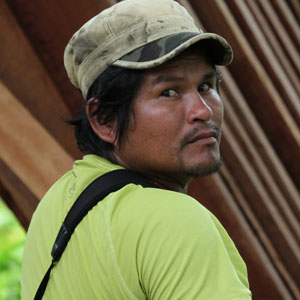 |
|
| Ron Allicock | Gary Sway |
PRINTABLE ITINERARY
CUSTOM TOURS
Contact us to custom-build an itinerary to seek out the bird species you are most interested in seeing.
TRIP PLANNING
INSURANCE The purchase of trip cancellation insurance is strongly recommended. Ron Allicock Birding Tours (RABT) cannot accept liability for airline cancellations or delays or penalties incurred by the purchase of non-refundable airline tickets or other expenses incurred by tour participants in preparing for this tour.
INTERNATIONAL TRAVEL You are responsible for arranging your flights to and from Georgetown. It is always good to arrive in good time for a rest before early morning departure on day two. So, plan to arrive in Georgetown in good time.
Please review our Trip Planning page for additional suggestions and notices.
